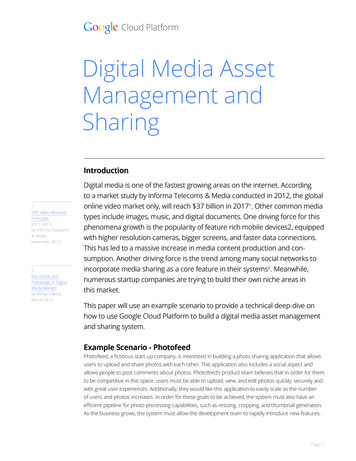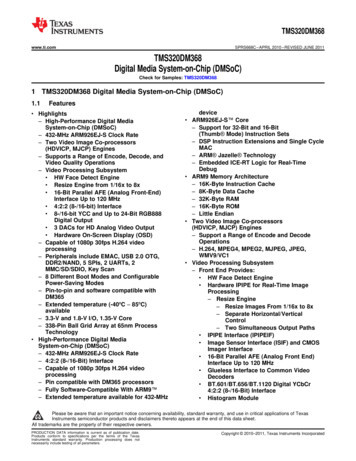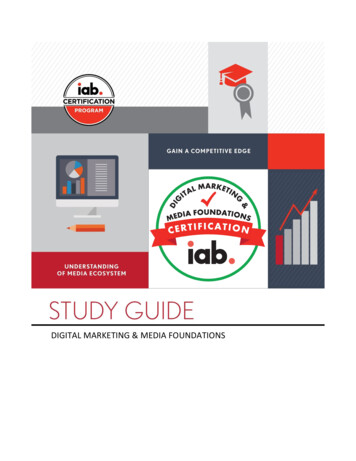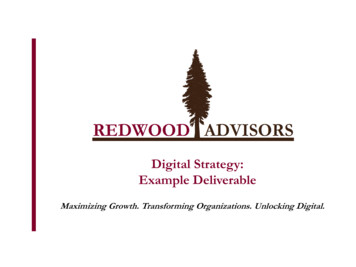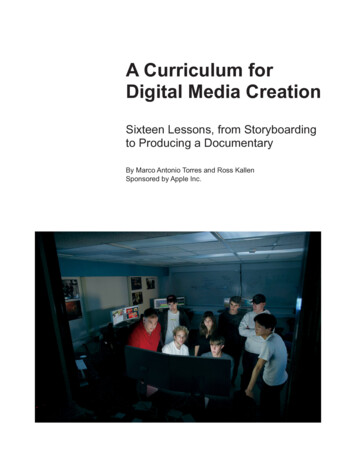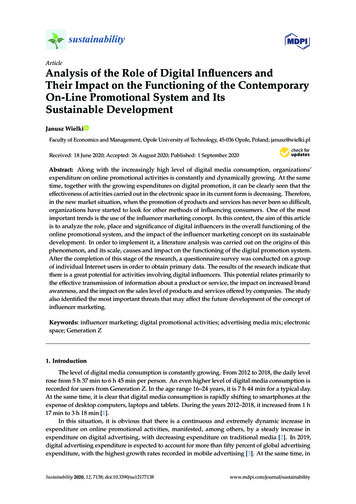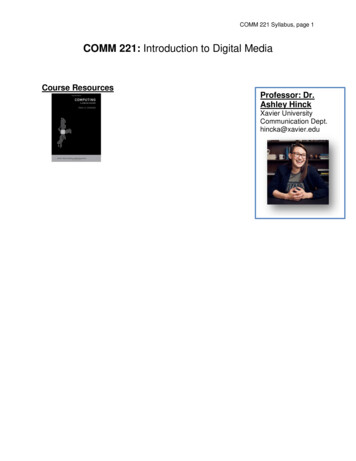
Transcription
COMM 221 Syllabus, page 1COMM 221: Introduction to Digital MediaCourse ResourcesProfessor: Dr.Ashley HinckXavier UniversityCommunication Dept.hincka@xavier.edu
COMM 221 Syllabus, page 2DESCRIPTION: What is this course all about?Course objectives/goals:1. Understand the history of computing, digital media, and the internet, along withthe implications of that history and how it is told;2. Understand and summarize major theories of digital media, includingtechnological determinism, social determinism, and technological affordances;3. Analyze digital communication, using key concepts like affordance, rhetoricalchoice, and audience;4. Interrogate the implications digital media offers for communication today.Course questions we will answer:1. Unit 1: What is the history of computing, digital media, and the internet?What are the implications of that history? What are the implications of how thathistory is told? What implications does that history have for digital communicationtoday?2. Unit 2: How can we critically analyze communication messages made withdigital media? How can we conceptualize the audience within a context ofdigital media? How can we account for the technological aspects ofcommunication made with digital media?3. Unit 3: What affects who can speak and who can be heard online? Howdoes a networked, many-to-many system affect communication with digitalmedia? How do race, gender, and class affect who can speak and be heardthrough digital media?Online Contexts: In this class, you are asked to engage in communication in class aswell as on online public sites. If you are uncomfortable with this, or if you require specialconsiderations, please see me in the first week of class.
COMM 221 Syllabus, page 3
COMM 221 Syllabus, page 4GRADES: What will you have to do in this class?Participation (30%):Twitter Posts:30 pointsProjects (30%):Communication Analysis Paper 30 pointsExams (40%):Midterm Exam20 pointsFinal Exam20 pointsTotal possible:100 pointsExtra Credit: There may be opportunities for extracredit throughout the semester. The number and types of opportunities will varydepending on the semester and class. The maximum amount of extra credit any singlestudent may earn is 2%.
COMM 221 Syllabus, page 5TWITTER PARTICIPATION ASSIGNMENTPart 1: Daily TweetsThe Assignment:Post three tweets for each class day:1) Post at least one tweet that responds to the reading. There are many ways to respondto the reading. The key is to respond in an honest and thoughtful way. Here are someof the ways you might choose to respond.-Your tweet may apply the reading to a new context.-Your tweet may give an additional example of a key concept form the reading.-Your tweet may critique the key argument of the reading.-Your tweet may disagree with the author.-Your tweet may offer an important question the author doesn’t answer, and thusa useful question to discuss in class.2) Post at least one tweet that responds to your classmates. As with the reading, thereare many ways to respond to your classmates. The key is to respond in a way that isboth kind (as we all learn together) and open (to learning from your classmates). Hereare some of the ways you might choose to respond.-You may explain how one of your classmates’ tweets helped you understand aconcept that you didn’t understand before.-You may disagree with one of your classmates’ tweets.-You may extend the argument one of your classmates makes, adding additionalevidence or ideas.-You may answer a question posed in your of your classmates’ tweets.The key here is to do more than simply agree with your classmate’s argument.3) Post at least one question. This might be a clarification question (something you don’tunderstand—a concept that is still fuzzy) or a question for discussion (an interestingidea that you’d like to pursue or hear what other people are thinking about).Notes about your tweets: Your tweets can be tentative. They don’t have to be final thoughts that you have nodoubt about. There is room for fuzziness, uncertainty, and risk in learning. Your tweets must use the course hashtag #XUCOMM221 (otherwise, we won’t beable to find them!).Twitter Account:
COMM 221 Syllabus, page 6 This assignment is an opportunity to begin to build a professional online identity.Many of us use social media for both personal purposes in personal contexts (sharewith friends and family) and for professional purposes in professional contexts. danahboyd calls these collapsing contexts—your boss can see the same thing your mom can.One way to manage these collapsing contexts is to have multiple social mediaaccounts—one for your professional contacts and posts and one for your personalcontacts and posts. This assignment falls into the professional category—these tweetsdemonstrate your expertise in digital media.If you do not have a twitter account, start a professional twitter account for thisassignment. If you already have a personal twitter account, start a new professionaltwitter account. You may also use a pseudonym, rather than your real name, but besure to choose a relatively professional pseudonym. If you have extenuatingcircumstances that make posting online dangerous or problematic for you, let meknow ASAP.Due Date: Each tweet is due before class begins.Learning Goals:This part of the assignment serves three goals:1) For time in class to be most useful, you must come to class prepared—that means Iexpect you to read and engage the assigned material before class. This assignmentencourages you to read the material carefully.2) This assignment allows you to learn from your classmates. One of the reasons Xavier’seducation is so powerful (and so unique) is that you have an opportunity to learn withother really smart students. By making our thoughts, reactions, and critiques aboutthe reading public for each student to see, we have the opportunity to learn from eachother (That’s why we’re not doing this on pen and paper).3) This assignment offers the opportunity to learn to use Twitter, a major digital mediaplatform. It allows us to reflect on its technical affordances (favorites, @mentions,etc.) and its community norms.Part 2: Turning in your tweetsThe Assignment:At three points in the semester, I’d like you to “turn in” your tweets by turning in aMicrosoft Word document that gathers your tweets in one place by taking screenshots ofyour tweets. This gives you more control over your twitter participation assignment and thegrade you earn. This is a chance to make sure you get credit for all of your tweets (even for
COMM 221 Syllabus, page 7those times you forgot to use the course hashtag). This is also a chance for you to make anargument for the quality of your tweets. Use this as an opportunity to demonstrate to me thatyou completed the Twitter Participation assignment at a high level. This is your chance togive evidence of both quantity (that you tweeted every class period) and quality (that yourtweets were evidence of engagement with the reading). This is also my chance to give youfeedback about your Twitter participation throughout the course of the semester.Section 1: Highlighted TweetsAt the top of your document, highlight two tweets: Choose one tweet that best shows your thoughtful response to the reading. Choose one tweet that best shows your openness to learning from your fellowstudents.Include a paragraph that explains and analyzes why you chose to highlight those particulartweets.Section 2: All of Your Tweets for This Period of the SemesterThen, put ALL of your tweets in a section below the highlighted tweets (including your twohighlighted tweets). Organize these tweets by class period (and label them as such—thereshould be a heading for each class period). All of your tweets should be in this section (yourhighlighted tweets should be here as well as in the top section). I should be able to easilycount the number of tweets here to see how many days you successfully completed thetwitter assignment.Due Dates:Tweets Batch #1 (10points)Due: T 9/18Include tweets for:1. R 8/232. T 8/283. R 8/304. T 9/45. R 9/66. T 9/117. R 9/13Tweets Batch #2 (10points)Due: T 10/23Include tweets for:1. T 9/182. R 9/203. T 9/254. R 9/275. T 10/96. R 10/117. T 10/168. R 10/18Tweets Batch #3(10 points)Due: T 12/11Include tweetsfor:1. T 10/232. T 11/133. R 11/154. T 11/205. T 11/276. R 11/297. T 12/4
COMM 221 Syllabus, page 8Total Points Possible: 30 points totalTurn in: Upload the word document to Canvas (.doc or .docx)COMMUNICATION ANALYSIS PAPERThe Assignment:This assignment invites you to explore the rhetorical dynamics of your own communicationonline. This will require you to develop critical distance to evaluate your owncommunication practices and will require you to practice using three key theoretical terms:rhetorical choices, audience, and technical affordances.Choose three instances in which you engage in public communication online. Use variety inyour posts: post to a wide range of websites, using a wide range of topics, for a wide range ofcommunities, with a wide range of rhetorical strategies. Do not use one of your readingresponse tweets for this paper. I want you to analyze your everyday communication in amore natural setting, rather than a setting designed for this class. For each instance ofcommunication, analyze your rhetorical choices, the audience, and the affordances at play.Explain how these affect the communicative interaction.Your essay should be 1,300-1,500 words, single or double-spaced. Include at least one screenshot of each of your original posts as well as any responses you receive. Because you areanalyzing your own communication, you may use first person. Because this is an analyticalessay, you should use academic prose for your essay. You can think of your audience as yourclassmates—people who are familiar with the terms we learned in class.You can organize your paper in many ways, but students often find the easiest organizationalstructure to be:Paragraph 1: Post 1, Rhetorical choicesParagraph 2: Post 1, AudienceParagraph 3: Post 1, AffordancesParagraph 4: Post 2, Rhetorical choicesParagraph 5: Post 2, AudienceParagraph 6: Post 2, Affordances
COMM 221 Syllabus, page 9Paragraph 7: Post 3, Rhetorical choicesParagraph 8: Post 3, AudienceParagraph 9: Post 3, AffordancesRough Draft due for Peer Critique Date: Thursday, November 1, 2018Revised Draft due for In-Class Revision Workshop: Tuesday, November 6, 2018Final Due Date: Thursday, November 8, 2018Optional Revision Due: Thursday, November 29, 2018Optional Revision: After you receive my feedback, you may choose to revise your essay.Highlight your revisions in yellow or use track-changes. To be eligible for the optionalrevision, you must turn in a full, complete paper at the original due date. Your new revisiongrade will replace your previous grade. Your new revision must still be within the wordlimit.Turn In: Submit file (.docx or .pdf) to CanvasTotal Points: 30 pointsRubric:Analysis of Rhetorical Choices*What is your rhetorical goal?*What rhetorical choices did you make?*How did those rhetorical choices help you achieve yourrhetorical goal?Analysis of Audience Social Norms*Who is your audience? Be specific. Name them. What aretheir demographics?*What are the social norms/expectations of your audience?What are their values, beliefs, and/or standards orcommunication?*How did you post meet or violate those norms?Analysis of Technical Affordances*What are the affordances of the platform you posted on?*What affordances did you use? Why?*What affordances did you choose not to use? Why?Overall Clarity of Writing5 4Meets allcriteria athigh level3 2Meets somecriteria;uneven1 0Meets fewcriteria5 4Meets allcriteria athigh level3 2Meets somecriteria;uneven1 0Meets fewcriteria5 4Meets allcriteria athigh level10 9 83 2Meets somecriteria;uneven7 6 5 41 0Meets fewcriteria3 2 1 0
COMM 221 Syllabus, page 10*Writing makes sense and is easy to follow*The paper is within the word limit*Structure is made clear with effective topic sentences,previews, and transitions*Writing is clear and concise*Avoids errors in grammar, punctuation, usage, and spelling*At least one screen shot was included of each postPeer Critique*Full, complete rough draft ready for Peer Critique Day*Peer critique is specific and precise (no rubber-stamping)*Peer critique is kind, generous, and collaborative (embodiesgood critique norms)*Writer makes changes on Final Draft based on commentsfrom Peer CritiqueMeets allcriteria athigh levelMeets somecriteria;unevenMeets fewcriteria5 4Meets allcriteria athigh level3 2Meets somecriteria;uneven1 0Meets fewcriteriaSCHEDULE: When are readings and assignments due?COURSE INTRODUCTION:Day 1: T 8/21 (Syllabus) Read the Syllabus before class Read the “Advice for Future tmlDay 2: R 8/23 (Learning/Pedagogy) Freire, Chapter 2 (pdf) As you read Audrey Watters’ blog post, think about how Canvas (aka theLearning Management System) affects learning—what kinds of things does itallow us to do? What kinds of things does it not do well? When should we use ornot use the LMS? What does this case teach use about questions we should askabout how technology affects our learning? -the-lms-newcastle-university Sherri Spelic is a teacher and an expert in education, pedagogy, and classdesign. This particular YouTube video brings up questions of equity in education andhow we design classes. She responds to the question: ““How would you designlearning environments, exercises and even education in general if your aim was tosuppress marginalized communities?” Sherri answers that question from her own perspective—that of designing physical education classes. As you watch her video,think about how the choices we make in our class policies and structures affectequity and fairness—that is, how those class policies and structures mightunfairly punish some students and not others.https://www.youtube.com/watch?v slQ-WqBiykUMaha Bali: Thinking about the justification for deadlines and late nts/UNIT 1: DIGITAL MEDIA HISTORY:
COMM 221 Syllabus, page 11Day 3: T 8/28 (Technological Determinism) Baym Chapter 2 (pdf):Day 4: R 8/30: (Components of a Computer) Ceruzzi, Intro and Chapter 1 (textbook) Crash Course: Early Computing:https://www.youtube.com/watch?v O5nskjZ GoIDay 5: T 9/4 (Ada Lovelace) Padua (pdf) [be sure to read the footnotes, not the endnotes] The New York Times obituary for Ada obituaries/overlooked-adalovelace.html Read Ceruzzi, page 28 (he refers to Ada Lovelace as Ada Augusta) Poke around online searching for Ada Lovelace DayDay 6: R 9/6 (The First Computers) Ceruzzi, Chapter 2 (textbook) Crash Course: Electronic Computing:https://www.youtube.com/watch?v LN0ucKNX0hcDay 7: T 9/11 (Colossus and ENIAC Programmers) Abbate, Chapter 1 (pdf) Crash Course, Alan Turing:https://www.youtube.com/watch?v 7TycxwFmdB0&list PL8dPuuaLjXtNlUrzyH5r6jN9ulIgZBpdo&index 16Day 8: R 9/13 (Mainframes) Ceruzzi, Chapter 3 (textbook)Day 9: T 9/18 (The Integrated Circuit) **Tweets #1 due (8/23-9/13) Ceruzzi, Chapter 4 (textbook) Crash Course: Integrated Circuits & Moore’s Law:https://www.youtube.com/watch?v 6tKOHICqrI&list PL8dPuuaLjXtNlUrzyH5r6jN9ulIgZBpdo&index 18 Joyner, “Jerry Lawson: The Black Man Who Revolutionized Gaming As WeKnow It”: ow-itDay 10: R 9/20 (Navajo Women and Microchips) Nakamura: rcuits/Day 11: T 9/25 (The Personal Computer & Class Agency Check-In) Ceruzzi, Chapter 5 (textbook) Crash Course: The Personal Computer Revolution:https://www.youtube.com/watch?v M5BZou6C01w&list PL8dPuuaLjXtNlUrzyH5r6jN9ulIgZBpdo&index 26 [In class, Class Agency Check-in]Day 12: R 9/27 (The Internet) Ceruzzi, Chapter 6 and 7 (textbook)
COMM 221 Syllabus, page 12 Crash Course: The Internet:https://www.youtube.com/watch?v AEaKrq3SpW8&index 30&list PL8dPuuaLjXtNlUrzyH5r6jN9ulIgZBpdo Review for MidtermDay 13: T 10/2 (Midterm Exam) **Midterm ExamR 10/4 [no class: Fall Break]UNIT 2: KEY THEORETICAL TERMSDay 14: T 10/9 (Rhetorical Choices) Campbell & Huxman, Prologue & Chapter 1 (pdf)Day 15: R 10/11 (Rhetorical Choices) Palczewski, Ice, and Fritch, Chapter 2 (pdf) Context for Obama’s speech:o Read the excerpt from Robert Terrill’s article (pdf)o To see the video that caused such a controversy, watch the first 2 ½minutes of this YouTube video:https://www.youtube.com/watch?v tFYeTrQMHA8 Watch the first 15 minutes of Obama’s speech “A More Perfect Union” whilefollowing along with the text of the speech.o Video: https://www.youtube.com/watch?v zrp-v2tHaDoo Text to follow along obamaperfectunion.htmDay 16: T 10/16 (Context & Audiences) Hauser, Chapter 3 (pdf) Context for Fisher’s speecho Excerpt from Lucas’ Top 100 American Speeches (pdf)o Excerpt from McGee (.doc) Watch Mary Fisher’s 15-minute speech, “A Whisper of AIDS”, while followingalong with the text of the speech.o Video: https://www.youtube.com/watch?v zB5K9k SOoo Text to follow along sher1992rnc.htmlDay 17: R 10/18 (Audience Online) PBS Idea Channel, "Are there internet dialects?": https://youtu.be/SDPasRas5u0 Baym, Chapter 4 (pdf)Day 18: T 10/23 (Technical Affordances) **Tweets #2 due (9/18-10/18) Winner (pdf) Pandel, “An Oral History of the History of ory-hashtag/Day 19: R 10/25: (Writing Papers) online class [Dr. Hinck at conference] Start writing your papersDay 20: T 10/30 (Putting it all together) Keep writing your papers
COMM 221 Syllabus, page 13 [In class practice analysis]Day 21: R 11/1 (Peer Review) **Rough Draft of Analysis Paper due (bring 3 copies to class)Day 22: T 11/6 (Revision Workshop) **Bring revised draft of paper, based on Peer Review comments In class revision workshop and writingDay 23: R 11/8 (Analysis Paper due) no class **Analysis Paper dueUNIT 3: WHO GETS TO SPEAK AND WHO GETS TO BE HEARD ON THEINTERNET?Day 24: T 11/13 (Networked Publics & Class Agency Check-In) Class Agency Check-In Watch short 10 minute mini-lecture on the public sphere (video on Canvas) Benkler, Chapters 6-7 (pdf)Day 25: R 11/15 (The Long Tail) Hindman, Chapter 3 (pdf)Day 26: T 11/20 (Gender) Kimberle Crenshaw, “Intersectionality” Ted Talk:https://www.ted.com/talks/kimberle crenshaw the urgency of intersectionality?language en&utm campaign tedspread&utm medium referral&utm source tedcomshare Naomi Extra, “The Black Feminist Who Argued for Intersectionality Before theTerm Existed”: https://broadly.vice.com/en ty-black-feminist Allen, “Gender Matters” (pdf)R 11/22: [no class: Thanksgiving Break]Day 27: T 11/27 (Gender Online) Hess, "Why women aren't welcome on the nd-behavior/women-arent-welcomeinternet-72170/ John Oliver, “Online Harassment: Last Week Tonight with John Oliver (HBO)”https://www.youtube.com/watch?v PuNIwYsz7PI Campbell, “Gaming’s toxic men, 93516/video-game-culture-toxic-menexplained Cauterucci, “New Chrome App Helps Women Stop Saying ‘Just’ and ‘Sorry’ inEmails,”http://www.slate.com/blogs/xx factor/2015/12/29/new chrome app helps women stop saying just and sorry in emails.html Dash, “The Year I Didn’t Retweet Men,” ear-i-didnt-retweet-men-79403a7eade1 Sayagues, “Technology Isn’t for Women,” s-not-for-women#.W0kfwLxaL3c.twitterDay 28: R 11/29 (Race)
COMM 221 Syllabus, page 14 **Optional Revision of Analysis Paper dueAllen, “Race Matters” (pdf)Watch the videos in the “What is Systemic Racism?” playlist (8 1-minute videos):https://www.youtube.com/watch?v GPVXdjJCkCA&list PL4ruTyc9FHOXSQYNEOQ7ePGQReN9sf5tb Taylor, “What is race” comic, https://thenib.com/what-is-raceDay 29: T 12/4 (Race Online) Vogt and Goldman, "Race Swap": http://www.onthemedia.org/story/tldr-31-raceswap/ Hempel, “For Nextdoor, eliminating racism is no quick eliminating-racism-is-no-quick-fix/ Ellis, “Want to Profit Off Your Meme? Good Luck If You Aren’t me-monetizationgap/?mbid social fb onsiteshare Jackson, “We Need to Talk About Digital Blackface in Reaction ckface-reaction-gifs Connor, “Giphy Debuts Collection of Black Ass GIFs Created by Black AssArtists”: -black-ass-gifscreated-by-bl-1833020498Day 30: R 12/6 (Final Exam Review & Reflection) Instead of responding to the reading, I'd like you to reflect back on the active learningstyle we embraced this semester, setting aside the banking model for a problemposing orientation. In your three tweets for today, reflect a little bit about how youadjusted your learning practices. What worked well for you? What didn't work well?What tips do you have to share with others? What would you tell future studentstaking COMM221 about how they should go about learning? Do course evaluations in class Review for Final ExamFinal Exam: 12/11 **Tweets #3 due (10/23-12/4) **Final exam: Tuesday, December 11 @10:30am-12:20pm
COMM 221 Syllabus, page 15BIBLIOGRAPHY: Where did our course readings come from?Abbate, Janet. Recoding Gender: Women’s Changing Participation in Computing. History ofComputing. Cambridge, Mass: MIT Press, 2012.Allen, Brenda. Difference Matters: Communicating Social Identity. Long Grove IL:Waveland Press, 2004.Bali, M. (2018, December 24). Negotiating Lateness Policies with Students. Retrieved July 10,2019, from Reflecting Allowed website: /negotiating-lateness-policies-with-students/Baym, Nancy. Personal Connections in the Digital Age. Malden, MA: Polity, 2010.Benkler, Yochai. The Wealth of Networks: How Social Production Transforms Markets andFreedom. New Haven [Conn.]: Yale University Press, 2006.Campbell, Colin. “Gaming’s Toxic Men, Explained.” Polygon, July 25, deo-game-culture-toxic-menexplained.Campbell, Karlyn Kohrs, and Susan Schultz Huxman. The Rhetorical Act: Thinking,Speaking, and Writing Critically. 4th ed. Boston, MA: Wadsworth Cenage Learning,2009.Cauterucci, Christina. “New Chrome App Helps Women Stop Saying ‘just’ and ‘sorry’ inEmails.” Slate, December 19, 2015.http://www.slate.com/blogs/xx factor/2015/12/29/new chrome app helps women stop saying just and sorry in emails.html.Ceruzzi, Paul E. Computing: A Concise History. The MIT Press Essential Knowledge Series.Cambridge, Mass: MIT Press, 2012.Connor, J. (2019, March 3). GIPHY, Refinery29 Join Forces to Create New GIF CollectionCreated by Black Artists. The Root. Retrieved from . Crash Course Computer Science YouTube Channel, 2017.https://www.youtube.com/watch?v O5nskjZ GoI&list PLMEKWdxI8dcaHSzzRsNuOLXtM2Ep C7a&index 1&t 316s.Crenshaw, K. (2016). The urgency of intersectionality. Retrieved fromhttps://www.ted.com/talks/kimberle crenshaw the urgency of intersectionalityDash, A. (2014, February 13). The Year I Didn’t Retweet Men. Retrieved July 10, 2019, fromMedium: The Only Woman in the Room website: ear-i-didnt-retweet-men-79403a7eade1Ellis, Emma Grey. “Want to Profit off Your Meme? Good Luck If You Aren’t White.”WIRED, March 1, 2017. ation-gap/.Extra, N. (2018, March 23). The Black Feminist Who Argued for Intersectionality Before theTerm Existed - VICE. VICE. Retrieved from
COMM 221 Syllabus, page 16https://www.vice.com/en ityblack-feministFatherOctavian. (2008). Bill Moyers - Rev. Wright’s “God Damn America” in Context.Retrieved from https://www.youtube.com/watch?v tFYeTrQMHA8Fisher, M. (1992, August). A Whisper of AIDS.Freire, Paulo. Pedagogy of the Oppressed. 30th anniversary ed. New York: Continuum, 2000.Hauser, Gerald A. Introduction to Rhetorical Theory. Reissued. Illinois: Waveland Press,1991.Hempel, Jessi. “For Nextdoor, Eliminating Racism Is No Quick Fix.” WIRED, February 16,2017. ting-racism-is-no-quickfix/.Hess, Amanda. “The Next Civil Rights Issue: Why Women Aren’t Welcome on the Internet.”Pacific Standard, January 6, 2014. /women-arent-welcome-internet-72170/.Hindman, Matthew. The Myth of Digital Democracy. Princeton: Princeton University Press,2009.Jackson, Lauren Michele. “We Need to Talk About Digital Blackface in GIFs.” Teen Vogue,August 2, 2017. eaction-gifs.Joyner, J. (2019, February 28). Jerry Lawson: The Black Man Who Revolutionized Gaming AsWe Know It - IGN. IGN. Retrieved e-know-itLastWeekTonight. (2015). Online Harassment: Last Week Tonight with John Oliver (HBO) .Retrieved from https://www.youtube.com/watch?v PuNIwYsz7PILucas, S., & Medhurst, M. (2009). Words of a Century: The Top 100 American Speeches,1900-1999. New York: Oxford University Press.McGee, J. J. (2003). A Pilgrim’s Progress: Metaphor in the Rhetoric of Mary Fisher, AIDSActivist. Women’s Studies in Communication, 26(2), 191–213.Miller, C. C. (2018, March 8). Ada Lovelace, Mathematician Who Wrote the First ComputerProgram. The New York Times. Retrieved a-lovelace.htmlNakamura, Lisa. “Indigenous Circuits.” Computer History Museum, January 2, us-circuits/.Obama, B. (2008, March). A More Perfect Union. Presented at the Democratic NationalConvention, San Diego.Padua, Sydney. The Thrilling Adventures of Lovelace and Babbage: With Interesting &Curious Anecdotes of Celebrated and Distinguished Characters Fully Illustrating aVariety of Instructive and Amusing Scenes; as Performed within and without theRemarkable Difference Engine. New York: Pantheon Books, 2015.
COMM 221 Syllabus, page 17Palczewski, Catherine Helen, Richard Ice, and John Fritch. Rhetoric in Civic Life. StateCollege, Pa: Strata Pub, 2012.Paling, Emma. “Wikipedia’s Hostility to Women.” The Atlantic, October 21, Pandell, Lexi. “An Oral History of the #Hashtag.” WIRED, May 19, shtag/.PBS Idea Channel. Are There Internet Dialects? PBS Digital Studios: PBS Idea Channel, 2014.https://www.youtube.com/watch?v SDPasRas5u0&feature youtu.be.Race Forward. (2015). What Is Systemic Racism? - Wealth Gap. Retrieved fromhttps://www.youtube.com/watch?v GPVXdjJCkCA&list PL4ruTyc9FHOXSQYNEOQ7ePGQReN9sf5tbSayagues, M. (2018, July 13). ‘Technology is not for women.’ The M&G Online. Retrievedfrom is-not-for-women/Spelic, S. (2017). Sherri Spelic: Provocation for #TowardsOpenness at #OEB17. Retrievedfrom https://www.youtube.com/watch?v slQ-WqBiykUTaylor, W. (2017, February 24). What is Race? Retrieved July 10, 2019, from The Nibwebsite: https://thenib.com/what-is-raceTerrill, R. E. (2009). Unity and Duality in Barack Obama’s “A More Perfect Union.”Quarterly Journal of Speech, 95(4), 2Vogt, PJ, and Alex Goldman. Race Swap on the Web. Accessed August 21, wap/?utm source sharedUrl&utm medium metatag&utm campaign sharedUrl.Watters, Audrey. The Monsters of Education Technology, 2014.Winner, Langdon. “Technologies as Forms of Life, and Do Artifacts Have Politics?” In TheWhale and the Reactor: A Search for Limits in an Age of High Technology, 3-18-39.Chicago: University of Chicago Press, 1989.
Microsoft Word document that gathers your tweets in one place by taking screenshots of your tweets. This gives you more control over your twitter participation assignment and the grade you earn. This is a chance to make sure you get credit for all of your tweets (even for . COMM 221 Syllabus, page 7 those times you forgot to use the course hashtag). This is also a chance for you to make an .
